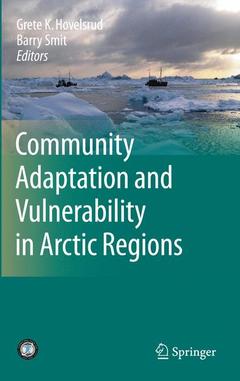Description
Community Adaptation and Vulnerability in Arctic Regions, 2010
Coordinators: Hovelsrud Grete K., Smit Barry
Language: English
Subjects for Community Adaptation and Vulnerability in Arctic Regions:
Publication date: 09-2010
353 p. · 15.5x23.5 cm · Hardback
353 p. · 15.5x23.5 cm · Hardback
Description
/li>Contents
/li>Comment
/li>
The ?Year? That Changed How We View the North This book is about a new theoretical approach that transformed the field of Arctic social studies and about a program called International Polar Year 2007?2008 (IPY) that altered the position of social research within the broader polar science. The concept for IPY was developed in 2003?2005; its vision was for researchers from many nations to work together to gain cro- disciplinary insight into planetary processes, to explore and increase our understanding of the polar regions, the Arctic and Antarctica, and of their roles in the global system. IPY 2007?2008, the fourth program of its kind, followed in the footsteps of its predecessors, the first IPY in 1882?1883, the second IPY in 1932?1933, and the third IPY (later renamed to ?International Geophysical Year? or IGY) in 1957?1958. All earlier IPY/IGY have been primarily geophysical initiatives, with their focus on meteorology, atmospheric and geomagnetic observations, and with additional emphasis on glaciology and sea ice circulation. As such, they excluded socio-economic disciplines and polar indigenous people, often deliberately, except for limited ethnographic and natural history collection work conducted by some expeditions of the first IPY. That once dominant vision biased heavily towards geophysics, oceanography, and ice-sheets, left little if any place for people, that is, the social sciences and the humanities, in what has been commonly viewed as the ?hard-core? polar research.
to the CAVIAR Project and Framework.- Adaptation in Fisheries and Municipalities: Three Communities in Northern Norway.- Vulnerability and Adaptation in Two Communities in the Inuvialuit Settlement Region.- Climate Change, Vulnerability and Adaptation Among Nenets Reindeer Herders.- Vulnerability of Community Infrastructure to Climate Change in Nunavut: A Case Study From Arctic Bay.- ‘Translating’ Vulnerability at the Community Level: Case Study From the Russian North.- ‘As Long as the Sun Shines, the Rivers Flow and Grass Grows’: Vulnerability, Adaptation and Environmental Change in Deninu Kue Traditional Territory, Northwest Territories.- Case Study Photographs.- The Ivalo River and its People: There Have Always Been Floods – What Is Different Now?.- Climate Change and Institutional Capacity in an ‘Arctic Gateway’ City: A CAVIAR Case Study of Whitehorse.- Climate Change Vulnerability and Food Security in Qeqertarsuaq, Greenland.- Climate Change, Vulnerability and Adaptive Capacity in a Multi-use Forest Municipality in Northern Sweden.- Local Effects of Global Climate Change: Differential Experiences of Sheep Farmers and Reindeer Herders in Unjárga/Nesseby, a Coastal Sámi Community in Northern Norway.- Community Adaptation and Vulnerability Integrated.
Documents and assesses the nature of vulnerability in communities across the entire Arctic Interdisciplinary research approach Demonstrates the importance of a shared analytical framework for comparing results across case studies Empirical examples of vulnerabilities and adaptive strategies from a region of the world commonly viewed as having high susceptibility to climate change
© 2024 LAVOISIER S.A.S.




